Today was a very exciting day in the history of the PRO Chess League: the day of the first in-person playoffs. Four teams — the Chengdu Pandas, Ljubljana Turtles, Armenia Eagles, and St. Louis Arch Bishops (the defending champions) came to San Francisco to face off in the two semifinal matches. The winners will go on to a final match tomorrow (and actually the losers will play a third-place match tomorrow, as well).
The first match, between Chengdu and Ljubljana, turned out to be somewhat lopsided (as expected). Let me explain that all PRO Chess League matches consist of four rounds, because each player from each team plays all four players from the other team. This is an innovation that gets away from the old 1 vs. 1, 2 vs. 2, 3 vs. 3, 4 vs. 4 format. Of course, it means also that you have four times as many games and therefore you need a time control that is four times quicker (game/15 with a 2-second increment, instead of game/60 with a 30-second increment).
In the very first round, the teams were even at 1½-1½ but Jure Borisek (#2 board for Ljubljana) seemed to have good winning chances against Xu Xiangyu (#3 board for Changdu). They got to the following position:
Black to move.
FEN: 8/pp2rp2/3n2p1/3P4/P4kPp/1P3B1P/3R1K2/8 b – – 0 1
Here it looks like a case of good knight versus bad bishop. Black’s knight on d6 is awesome, setting up an unbreakable blockade of the d-pawn, thus keeping White’s bishop bottled up, and protecting b7 and f7. Because the knight and king are already on their ideal squares, Black should be looking for the ideal square for his rook. 1. … Rc7 seems like the obvious move to me. White can’t stop the Black rook from penetrating to c3, c2, or c1, and the only question is how decisive that is.
But in a stunning turn of events, Black blundered the game away with 1. … Re4?? First, I’m not even sure what Black is trying to accomplish with this move, i.e., what he would do if White passes. But second, it is a huge gamble when huge gambles aren’t needed. If you have calculated incorrectly, you lose. Do you see what Black missed?
The answer is that he missed 2. Bxe4 Nxe4+ 3. Kg2! Obviously, Black fell prey to routine, “connect-the-dots” thinking, and believed that White had to play 3. Ke2, defending his rook. In fact, if 3. Ke2?? Nxd2 4. Kxd2 Ke5 or 3. Ke2?? Nxd2 4. d6 Nf3 5. d7 Nd4+ Black wins. But after 3. Kg2! there is no way for Black to gain a tempo with a check, so after 3. … Nxd2 4. d6 White’s pawn queens. Black played some other move, maybe 3. … Ke5, but the game was obviously over and he resigned just a few moves later.
This tragic turn of events turned the first round from a possible 2½-1½ win for Ljubljana into a 2½-1½ loss. After that the match was never really in doubt. Chengdu’s superior strength made itself apparent as they won the next two rounds by an identical margin, and then coasted home to a 9½-6½ victory. Though Chendu clearly seemed to be the stronger team, you have to wonder what would have happened if they had been forced to battle from behind instead of playing with the lead.
A relieved Xu is interviewed by Alexandra Botez after his miraculous escape against Jure Borisek.
Before I tell you what happened in the day’s second match, let me talk about how wonderfully organized this event was. They had to make sure everything was working: the sound system for the excellent commentary by Danny Rensch and Robert Hess, the video system, all the computer hookups. Each of the players had white-noise headphones that supposedly made it impossible for them to hear the live commentary or the crowd reactions. What an amazing idea! There were also nice details such as the team uniforms with logos that were provided to all of the players (see the panda logo on Xu’s shirt). Alexandra Botez conducted interviews between and during rounds, and she blew us away by interviewing one of the Chinese players in Mandarin. And let’s not forget that somebody had to pay for plane tickets to bring the players from the far corners of the Earth — Armenia, China, Slovenia, and St. Louis (well, not such a far corner in that case). It’s just an astounding organizational feat by a league that is only in its second season.
The venue itself, the Folsom Street Foundry, was not as large as I had expected, but it was certainly large enough for this event. I would guesstimate that the number of spectators was around 50 at any given time. The room was not packed, but it was comfortably full and the commentators (and players!) expressed their pleasure at hearing applause from the audience after the games ended. (Presumably after taking off the noise-cancelling headphones.)
The crowd watches the action in the Chengdu-Ljubljana match.
Between rounds I got a chance to talk with David Pruess, who has been an online commentator for the PRO Chess League this season but was at this even exclusively as a fan. He has scaled back his chess activity a great deal, because he is a new dad! Actually twice over (his daughter is 3, and his son is a few months old).
If you think outwitting grandmasters is hard, try outwitting a three-year-old who doesn’t want to eat her food…
Also in the crowd as a spectator was Hikaru Nakamura. I didn’t talk with him, but here he is being interviewed by the omnipresent Botez.
Here’s a look at how the competition was set up. The players are Dariusz Swiercz versus Zaven Andriasyan, from the St. Louis-Armenia match.
You can see the noise-canceling headsets and the computer screens that the players are looking at. I think it’s ironic that the players came thousands of miles to play against each other in person, but they actually don’t play with a chessboard and pieces, and they can’t even see each other during the game. They’re just looking at a computer screen, the same as they would if they were playing at home. Okay, I sort of understand why: it’s because the whole league is set up to use chess.com’s interface to the Internet, and otherwise you would have to go to the trouble of getting clocks and boards and sets with electronic sensors. Still, the league is seemingly awash in money (first prize is $20,000!). I hope that next year they will at least consider the possibility of having the players face each other over a real chessboard.
But you know what? Maybe I’m just old-fashioned. Probably all the players in the current generation are just as comfortable playing online as on a real board; maybe even more comfortable.
While the Chengdu-Ljubljana match was not very suspenseful, the St. Louis-Armenia match was very exciting and undecided right up to the final seconds, literally.
Going into the last round, the two teams were tied at 6-6.
As you could see from the photo if the resolution were better, the last round matchups (with the St. Louis players listed first) were Akobian vs. Andriasyan, Swiercz vs. Ter-Sahakyan, Zherebukh vs. Grigoryan, and Chen vs. Manukyan. Here’s a great action picture of Varuzhan Akobian on board one.
For the longest time it looked as if the match was going really well for the defending champs. Akobian and Andriasyan played a quick draw, but on the other three boards it looked like either a win or draw for St. Louis on boards three and four, and either a draw or a loss on board two.
But then a nightmare occurred for St. Louis, as each of the remaining games went the wrong way. Chen had to agree to a draw in a superior position because he had only 8 seconds on his clock. Zherebukh probably missed a zillion wins in a two-pawn-up endgame and was only able to draw. Finally, in the last game to finish, Ter-Sahakyan played Nf5 (as White) against Black’s shaky kingside with pawns on f7, g6, and h6. For a long time the knight couldn’t be taken, and you had an extremely tense position with the knight seemingly en prise but not really, and you wondered who was going to blink first. Was Swiercz finally going to have to accept the sacrifice, or was Ter-Sahakyan going to have to retreat?
In the end, Swiercz was forced to take. In a mad time scramble it could have gone either way, but Swiercz blundered first (he may have been losing anyway) and Ter-Sahakyan’s win clinched a thrilling 8½-7½ victory for Armenia.
Seconds after the game ended, Samvel Ter-Sahakyan (facing camera) is about to get enveloped in a bear hug from his three teammates.
So, where does this leave us? Tomorrow, Chengdu faces Armenia for the championship. I have to think that the Chinese team is a huge favorite, but you absolutely never know in this league. With only 15 minutes for each player, and so many games coming down to the final seconds, anything can happen.
Unfortunately I will not be able to watch the finals in person, but I will try to catch some of the action online. Meanwhile, just for fun, I will leave you with a couple pictures of leaning houses — one of my favorite things to photograph in San Francisco.
Tilted house #1
Tilted house #2
Already I can hear some of you saying, “Those houses aren’t tilted! They’re just…” Sssshhh! Don’t finish that sentence! Don’t spoil the fun!

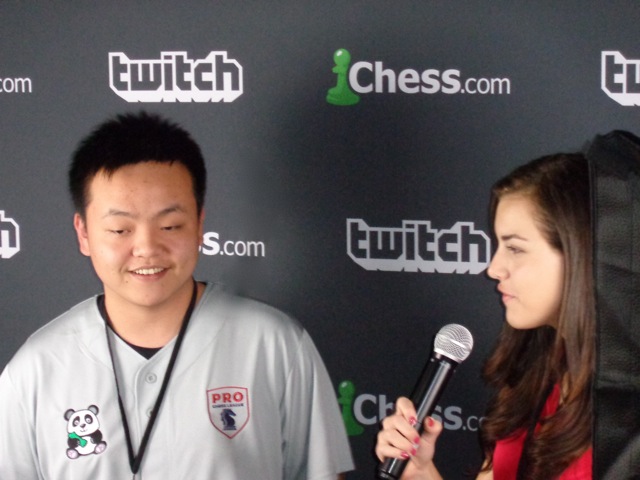


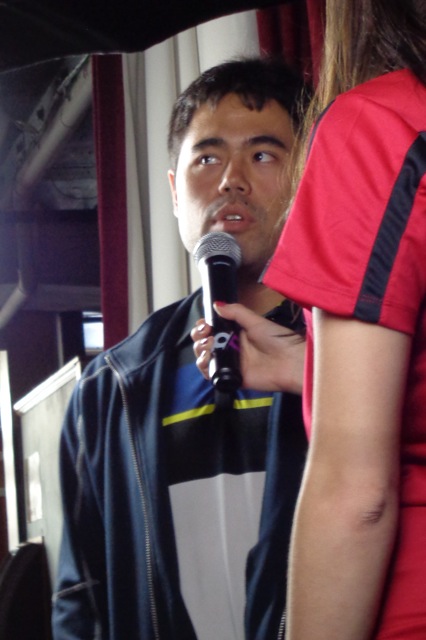

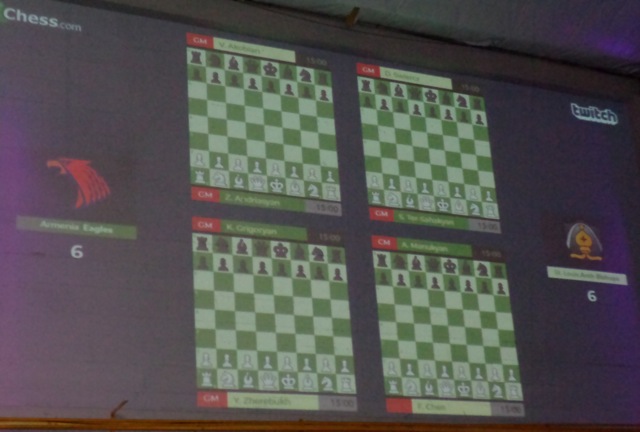
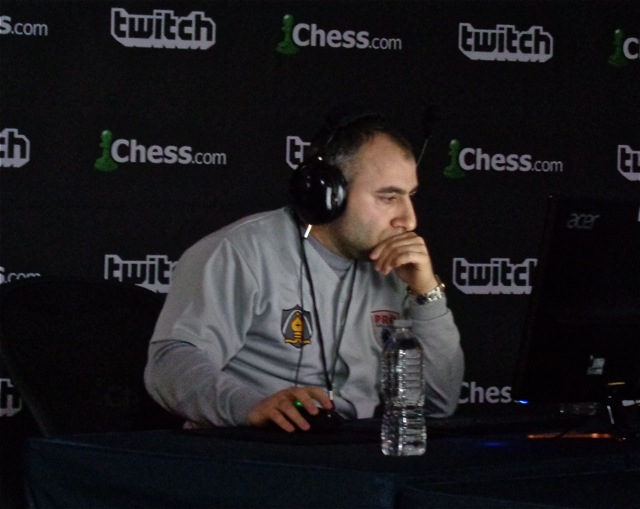
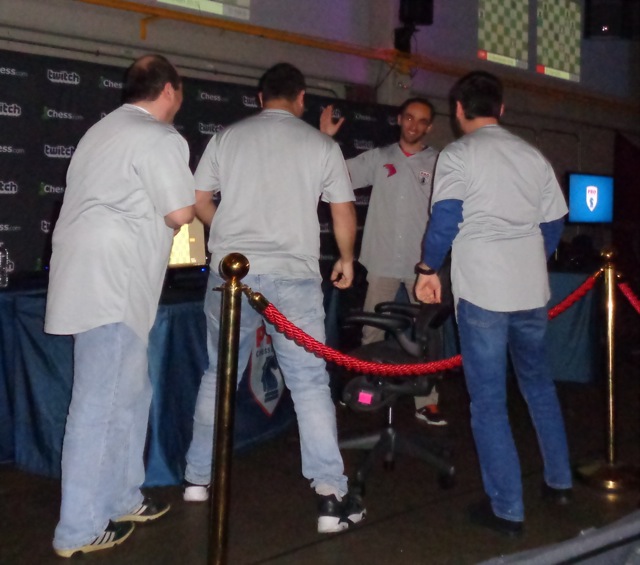

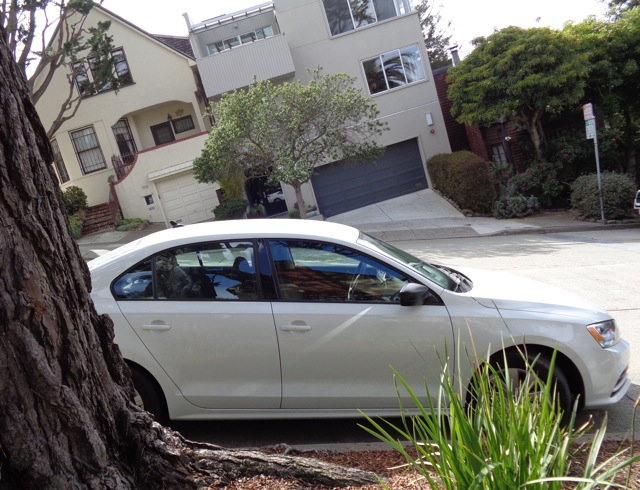



{ 2 comments… read them below or add one }
I, too, wondered why they didn’t play on actual physical boards, until I considered the myriad possibilities for touch-move disputes, pieces knocked over in time scrambles, and so on – none of which could occur using the computer interface through which all previous matches had been played.
It was great to be physically present myself, along with you, Dana! And I’ll accept the tilted houses, but I really must ask about how many corners the world has. I never pictured you as a flat-Earther. (And anyway, I thought most flat-Earthers fell off long ago, and as the remaining ones gradually fall off the edges, soon only us round-Earthers will be left, as we don’t have any edges to worry about….)
What a great comment! I can just imagine all the professors at the Flat Earth Academy, whose top research project is figuring out how many corners the earth has. And Flat Earth Conferences, with papers like “New Coordinate Systems for Pentagonal Worlds” and “Evidence for a Sixth Corner.” Dedicated to the memory of Prof. I. M. Flat, who tragically fell off the edge of the Earth while searching for the elusive sixth corner.
The image is sadly reminiscent of some real science …